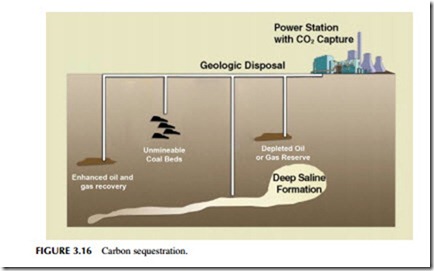CARBON DIOXIDE SEQUESTRATION
If carbon dioxide is to be captured during the use of coal (or any other fossil or carbon-based fuel) for electricity generation, then it must also be stored in such a way that it cannot ever enter the atmosphere. Otherwise the capture is pointless.
Various methods are being explored for achieving this but the most likely solution is that the carbon dioxide will be stored underground (Figure 3.16). Several options exist for this. One of the most obvious is to pump it into exhausted oil and gas fields. The infrastructure already exists to carry this out and carbon dioxide has been pumped into older oil fields to enhance oil recovery for many years so the technology is well understood. Questions remain about the security of the gas once it has been sequestered in this way, but in principle it could provide a safe means of storing the gas.
Exhausted wells offer a first choice for testing capture and sequestration technology, but they cannot provide the capacity that will be needed if this is to become a global practice. For that, underground geological formations such as aquifers are likely to be used. These are sites where an impermeable rock cap
traps liquids beneath it. Carbon dioxide can be pumped into such aquifers where it first displaces the brine already trapped there and eventually dissolves in it, potentially forming solid salts that are permanently held.
Some consideration has also been given to storing carbon dioxide in the world’s oceans. These are already the largest global carbon dioxide sinks, hold- ing around 20 times as much carbon dioxide as there is in the atmosphere and biosphere combined. However, there are too many uncertainties attached to this method of carbon dioxide disposal for it to be used today.
Once carbon sequestration sites have been found and stores established, then the carbon dioxide must be delivered to them. In most cases this is likely to be via a new carbon dioxide pipeline system. The gas must first be pressurized and then it can be pumped from power plants to the storage sites. The gas is normally pressurized between 10 MPa and 15 MPa, when it enters a supercritical state under which it has the density of a fluid though it can still behave like a gas. Tanker transportation might be feasible under some circumstances but it does not appear as economical as pipeline transportation.
